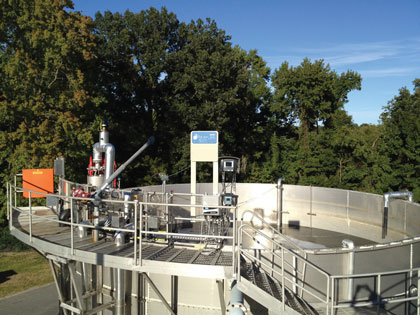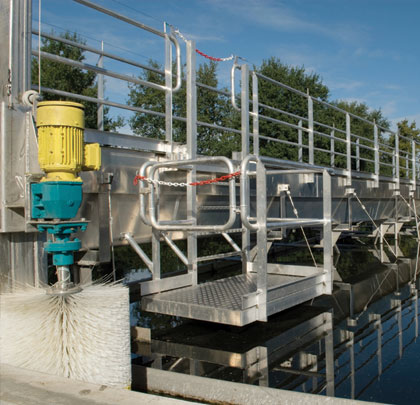Sustainable solutions can offer more than just environmental benefits. Green technologies can offer significant cost savings as well. Virginia utility Hampton Roads Sanitation District (HRSD) was looking for these when Chief of Special Projects, Charles Bott, approached World Water Works, a leading designer and manufacturer of wastewater treatment solutions, about the innovative and very environmentally friendly Demon® deammonification system.
This unique system replaces the complicated methods of conventional nitrogen removal with a two-step single-stage process that provides many benefits. In addition to reducing a facility’s energy requirements and carbon footprint, this process completely eliminates the need for chemicals. A few months after installation, HRSD has not only been presented with the American Association of Environmental Engineers and Scientists (AAEES) Honor Award for Environmental Sustainability, but is also on track to save $200,000 this year.
When companies talk about sustainable solutions, they often focus strictly on the environmental benefits and the upfront cost of the installation. However, with systems like the Demon® treatment process, innovations that help save the environment can also help to save your facility money.
UPGRADING CAPACITY WITH INNOVATION
HRSD operates thirteen different wastewater treatment plants across southeast Virginia, serving over 1.6 million people and handling a total of 249 million gallons (942 million liters) per day. Since its founding in 1940, the group has been dedicated to innovation in wastewater treatment, pioneering new technologies and even patenting unique processes.
HRSD initially approached the project from the perspective of cost management.
Responding to new regulations on wastewater quality, HRSD had added denitrification filters to its York River plant. This upgrade was undertaken with the expectation that the plant would be expanded from 15 million gallons (56.8 million liters) per day per day to 30 million gallons (113.5 million liters) per day, but when that expansion was delayed, they were left with a partial 15 million gallons (56.8 million liters) per day and partial 30 million gallons (113.5 million liters) per day plant that was very expensive to operate from a chemical standpoint.
Manager Charles Bott had seen operational Demon® systems while over in Europe, and when he returned stateside, he was sure this was the perfect solution for HRSD. “With a lot of these processes that are emerging in Europe, they almost seem too good to be true,” he explains. “But once you see them in action, and you see that they are accomplishing exactly what they promise. When I got back from Germany, I was dying for a Demon®.”

A CHEMICAL-FREE AND CARBON-FIXING PROCESS
The process was developed by researchers at the University of Innsbruck, led by Dr. Bernhard Wett, as an alternative to traditional methods for removing ammonia from wastewater.
Conventional nitrogen removal has required a large amount of energy, a carbon source—usually methanol, and often other chemicals as well. These systems use a multi-step nitrification/denitrification process: The waste ammonia (NH3) is oxidized to nitrite by ammonia oxidizing bacteria (AOB); this nitrite is oxidized again to nitrate by nitrite oxidizing bacteria (NOB); and then this nitrate is converted into nitrogen gas in two additional biological steps. The first two steps require relatively high levels of dissolved oxygen, supplied by blowers. The last two require an additional carbon source (usually methanol) and produce a large amount of sludge, which is expensive to handle and dispose.
Demon® changes all of this. It employs a two-step, single-stage process to provide equally effective nitrogen removal. First, the same ammonia oxidizing bacteria convert about half of the ammonia into nitrite. Next, a second class of bacteria (Anammox) converts the remaining ammonia with this nitrite to produce nitrogen gas. Anammox bacteria work in an anaerobic environment, so this second step requires no dissolved oxygen and therefore no extra energy. It also requires no methanol or other chemicals.
Overall, the system completely eliminates the need for chemicals, greatly reduces sludge handling volumes by up to 90 percent and reduces nitrogen removal energy requirements by up to 60 percent. In addition, since the Anammox consumes carbon dioxide, the process is carbon fixing and can reduce the carbon footprint of a wastewater treatment facility.
“When you look at the process and conventional nitrogen removal side-by-side, there’s really no comparison,” says Bott, “For a facility like the York River treatment plant, where the chemical costs were so expensive, a chemical-free process was exactly what we needed.”
THE FIRST NORTH AMERICAN INSTALLATION
Bott approached World Water Works, about installing a Demon® system at the York treatment plant because World Water Works first introduced the system to the North American market, and has the exclusive right to distribute the system in the United States.
For HRSD, World Water Works could see that it was just a perfect fit. First off, HRSD already had much of the right equipment. The plant’s existing batch reactors and equalization tanks could easily and quickly be retrofitted for the process. More importantly, though, they had people who understood the process and were invested in bringing the latest technologies to their facilities.
But a full scale Demon® system was yet to be installed outside of Europe. One of the main reasons for this was the need for seed Anammox bacteria in order to start up the system. It took two and a half years for Dr. Wett to cultivate enough bacteria for the first operating Demon® installation in Austria. Other European plants could obtain start-up Anammox from this plant, and purchase more if necessary to keep their installation running.
This would not be so easy for HRSD, since shipping the seed bacteria overseas would be both expensive and logistically difficult. But fortunately, World Water Works had the right relationships with European facilities and had already developed the infrastructure to supply Anammox to installations in the United States.
With this harvesting ability, World Water Works and HRSD were able to go through with the installation. Given the set-up at the York River plant, the relatively simple and inexpensive implementation took fewer than four months. Successful operation has continued since January.
“The start-up went very smoothly. World Water Works provided great technical support and great support overall,” says Bott.
LOW MAINTENANCE, HIGH REWARD
The York River Treatment Plant’s Demon® system has fulfilled the hopes HRSD had for it. Although the energy savings are harder to quantify, the chemical savings have been extremely significant. By reducing the volume of methanol and other chemicals used at the site, the utility will be able to save about $200,000 per year.
“Demon® would have reduced costs for any plant, but in this particular instance it significantly reduced costs from a chemical standpoint,” explains Bott.
The system is also low maintenance and, after a little getting used to, requires a low amount of operational oversight. A specially designed biomass separation device keeps bacteria levels stable and automated controls make system nearly worry-free.
The benefits of the system have also attracted a lot of outside interest. For bringing the system to North America, World Water Works and HRSD received the American Association of Environmental Engineers and Scientists Honor Award for Environmental Sustainability, and in the eight short months of operation, more than a dozen groups have stopped by to check it out.
“As I knew from my own experience, when you read about this sort of system, it can seem too good to be true,” says Bott, “But once you see it, once you’ve been in the plant and seen how it’s incorporated, you can really understand how it works. We’re always excited to introduce other groups to this system, since it’s been so successful for us.”
BEYOND YORK RIVER
And HRSD is only experiencing the minimum the process has to offer. For facilities looking to reduce energy requirements of a main treatment plant, Demon® can be integrated into the main stream solution and provide even more noticeable benefits with big energy cost savings in addition to the reduced chemical costs.
World Water Works has also developed WaterEnergy™, a process that integrates Demon, along with other systems, into a wastewater solution that can actually make facilities have 5 to 30 percent net positive rate of energy production. It may sound a little bold, but the technology is there and only requires an opportunity to make it happen—as seen with with Demon® and HRSD.
Breakthroughs in wastewater treatment hold a lot of promise for a greener future. But the key take away from the installation of the system at the York River Treatment Plant is that a green wastewater solution, like the Demon® process, can be very cost effective as well as sustainable. ■
[divider]
ABOUT THE AUTHOR
Chandler Johnson is the chief technology officer at World Water Works, manufacturer of specialized advanced water treatment solutions focused on performance, flexibility, and longevity. For more information, visit www.worldwaterworks.com.
MODERN PUMPING TODAY, August 2014
Did you enjoy this article?
Subscribe to the FREE Digital Edition of Modern Pumping Today Magazine!


